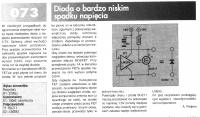mojomax wrote: 1. Are there diodes where the voltage drop would be smaller, e.g. 0.3V?
1. Is there any "one way conductive" element that would not have a voltage drop?
3. Is there a regulated zener diode where the voltage drop could be adjusted from 0 to 1V?
1. I think enough has been answered already; one could still consider LEDs
from other materials - except that the lower the voltage drop across the diode, the greater
reverse current - e.g. a diode that conducts 1A at 0.2V must have a reverse current
at least 1mA - this is due to thermodynamics; I guess the diodes are reversed
and tunnel diodes are not subject to this limitation - inverted diodes (so called because
that they let the current pass in the reverse direction and they retain it in the forward direction
like any normal diode - they conduct at about 0.6V), they are very sharp
transition between breakdown (reverse current) and no current at
low voltage in the forward direction; tunnel diodes have this breakdown to
a certain small voltage in the forward direction and when increasing the voltage
you reach an area where they are not yet very conductive, and breakthroughs are already
there is none, so the forward current decreases with increasing voltage - incl
in the range it is impossible to measure their characteristics - and still they conduct normally;
2.How to be zero voltage drop, reverse current is like conduction;
3. there are ICs that are voltage standards, and you can use them instead of diodes
Zener (they are much more accurate than them, have lower impedance, and above all
all by adding two resistors we set their "zener voltage") - but
their minimum operating voltage is 1.225V; maybe if such a system was made of another
material, e.g. germanium, it would be slightly smaller - around 0.8V, but it is not
it's easy, germanium gives too much reverse current; with lower tensions worse;
well, unless we lower the temperature, at the temperature of liquid nitrogen one could ...
Oh, and a curiosity - there is such a thing as a Josephson junction (at a temperature of
liquid helium - I do not know if it is possible in higher): at _zero_ voltage it lets go
current, but not at non-zero - starts to behave like an insulator; and more specifically,
it runs a current with a frequency proportional to the voltage, and these are quite large
frequency, so it is difficult to notice this current ...



